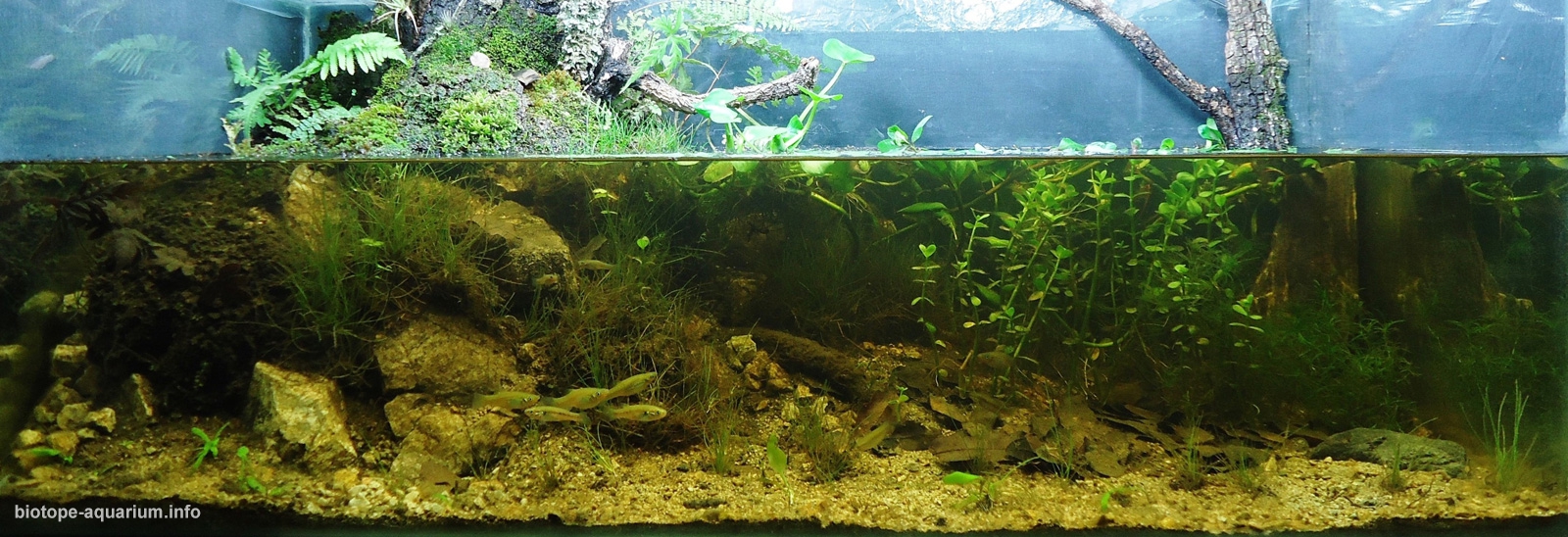Profundulus oaxacae habitat
The 2nd place in the qualifying stage of the Biotope Aquarium Design Contest 2014
![]() Mexico. Víctor Manuel Ortiz Cruz
Mexico. Víctor Manuel Ortiz Cruz

Volume: 140 L
List of fishes: Profundulus oaxacae, Poecilia sphenops
List of plants: Eleocharis parvula, Bacopa monnieri, Chara sp., Ludwigia peploides, Sphagnum sp., Pteridophytes sp., Fissidens crispus, Azolla caroliniana, Heteranthera reniformis, unknown species
Biotope description: This aquarium was set up based on the recently discovered population of the killifish Profundulus oaxacae, a species about which very little is known and which is on the border of extinction due to the destruction and contamination of the watershed in which it was abundant until several decades ago (the river Atoyac in the state of Oaxaca, Mexico). The habitat in which the 2nd confirmed existing population of this species was found is a micro watershed. More specifically it is the source of a stream which finds its way through a ravine surrounded by oak trees that constantly shed their leaves in the stream, and forming different small pools. The first known population is located several kilometers away from the newly discovered and their habitat (which was recreated for the contest), so they have no communication and are different populations. The stream finds its way through whitish rocks and the border is littered with small wooden trunks and roots, both covered with mosses with a large quantity of ferns, followed in abundance by Eleocharis parvula (there are other species of the same genus but this is the species that is in direct contact with the water). In the pools a native water lily can be found, as well as Ludwigia peploides, Bacopa monnieri, the macro algae Chara sp. At the bottom of the stream a small rosette type plant is found which has not been identified up to now. The bottom of the stream is mostly sandy covered with organic matter due to the decomposition of the oak leaves. It is worthwhile mentioning that the area of the recently discovered population of the Oaxacan killifish, is seriously threatened due to the advancing limits of the urban population. For this reason, the local municipal authority, together with a collective of environmentalists and the expertise of an aquatic biologist, that discovered the population, tries to protect this area and the Profundulus oaxacae. Through the participation in this contest we try to generate interest and awareness about these efforts in order to obtain support of those interested.

Although the Profundulus biotope aquarium has also won 1st place at the Croatian Biotope Contest (voted by me), in this JBL-contest it became my second placed with 2 points behind, my 1st was The Everglades National Park (which I see Jeremy also agreed). The problem I have, is that I have been to both places (and I guess almost all other biotopes from this contest), and the Profundulus lives among roundish rocks, in fast flowing habitats, not pointed rocks and not so much submerse vegetation.

Complex but well thought out aquascape that combines good hardscape and planting with a natural look and what is sure to be a great habitat for the fish residing there.

It’s a great layout of a natural biotope. The setup is a nearly perfect imitation of the original. Plants, fishes and the decoration represent a wonderful part of nature. Really special about this tank is the muddy ground and shoreline. It looks like it’s cut out of the real biotope. All in all the perfect environment for an endangered species.

It is a leader, without a doubt. Its design is complex in technical terms, but there is nothing excessive here. Attention is paid to every detail. I am sure that the fish taken from their native habitat to this biotope aquarium, did not even noticed that they were moved from their native environment to this aquarium.

This is one of the most beautiful in the Biotope Contest. Everything from the arrangement of stones, plants and leaves inspires authentic biotope and is also seeking the preservation of an endangered endemic species. Congratulations!

Extremely sophisticated biotope aquarium. The substrate, plants and other “décor” are covered in junk, just like in the biotope. The “periphyton covered look” is hard to recreate and it makes an aquarium look so natural.

Outstanding example of what first-hand research and attention to detail can yield! Based on personal observations, the bank of this small, specific stream in Oaxaca is recreated as though a memory has come to life. It has a rough and wild look, a bit “wooly”. What is perhaps most impressive is that it looks mature, as though it has been growing and developing just as in nature: the leaves are partially decayed and distributed according to the current, stones are partly exposed above the substrate and coated with a fuzz of algae, the plants grow in zones according to the proximity to the bank, coming out from between the rocks. The bank extends above the surface, with mosses partially submerged, and very naturally sloping into deeper water with stones and roots providing the framework to support it. From close-up photos, you would not know this is an aquarium! And the fish are schooling and foraging just as they would in the wild. The great art of this tank is the way the aesthetics have been maintained without sacrificing the authenticity of this particular biotope. Photos of this biotope in the wild are quite consistent with what is represented here.
